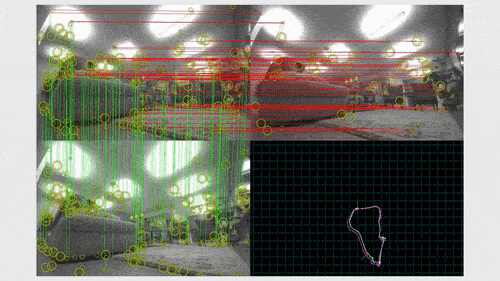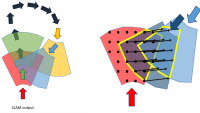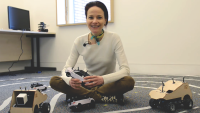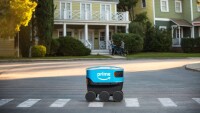Events & Conferences
The science behind Astro’s graceful, responsive motion

With Astro, we are building something that was a distant dream just a few years ago: a mobile robot that can move with grace and confidence, can interact with human users, and is available at a consumer-friendly price.
Since Astro is a consumer robot, its sensor field of view and onboard computational capabilities are highly constrained. They are orders of magnitude less powerful than those of some vehicles used in industrial applications and academic research. Delivering state-of-the-art quality of motion under such constraints is challenging and necessitates innovation in the underlying science and technology. But that is what makes the problem exciting to researchers and to the broader robotics community.
This blog post describes the innovations in algorithm and software design that enable Astro to move gracefully in the real world. We talk about how predictive planning, handling uncertainties, and robust and fast optimization are at the heart of Astro’s motion planning. We also give an overview of Astro’s planning system and how each layer handles specific spatial and temporal aspects of the motion-planning problem.
Computation, latency, and smoothness of motion
For motion planning, one of the fundamental consequences of having limited computational capacity is a large sensing-to-actuation latency: it can take substantial time to process sensor data and to plan robot movements, which in turn has significant implications for smoothness of motion.
As an example, let’s assume it takes 500 milliseconds to process raw sensor data, to detect and track obstacles, and to plan the robot’s movements. That means that a robot moving at one meter per second would have moved 50 centimeters before the sensor data could have any influence on its movement! This can have a huge impact on not only safety but also smoothness of motion, as delayed corrections usually need to be larger, causing jerky movements.
Astro tries to explicitly compensate for this with predictive planning.
Predictive planning
Astro not only tries to predict movements of external objects (e.g., people) but also estimates where it will be and what the world will look like at the end of the current planning cycle, fully accounting for the latencies in the sensing, mapping, and planning pipeline. Astro’s plans are based on fast-forwarded states: they’re not based just on the latest sensor data but on what Astro believes the world will look like in the near future, when the plan will actually take effect.
If the predictions are reasonably good, this kind of predictive planning can critically reduce the impact of unavoidable latencies, and Astro’s observed smoothness of motion depends in large part on our predictive planning framework. However, that framework requires careful handling of uncertainties, as no prediction is ever going to be perfect.
Handling uncertainties
For motion planning, uncertainty can directly translate to risk of collision. Many existing academic methods either treat risk as a special type of constraint — e.g., allowing all motion if the risk is below some preset threshold (so-called chance constraints) — or rely on heuristic risk-reward tradeoffs (typically via a constant weighted sum of costs). These approaches tend to work well in cases where risk is low but do not generalize well to more challenging real-world scenarios.
Our approach relies on a unique formulation where the robot’s motivation to move toward the goal gets weighed dynamically via the perceived level of uncertainty. The objective function is constructed so that Astro evaluates uncertainty-adjusted progress for each candidate motion, which allows it to focus on getting to the goal when risk is low but focus on evasion when risk is high.
It is worth noting that in our formulation, there is no discrete transition between high-risk and low-risk modes, as the transition is handled via a unified, continuous cost formulation. Such absence of abrupt transitions is important for smoothness of motion.
When you see Astro automatically modulating its speed smoothly as it gets near obstacles and/or avoids an oncoming pedestrian, our probabilistic cost formulation is at play.
Trajectory optimization
To plan a trajectory (a time series of positions, velocities, and accelerations), Astro considers multiple candidate trajectories and chooses the best one in each planning cycle. Our formulation allows Astro to plan 10 times a second, evaluating a few hundred trajectory candidates in each instance. Each time, Astro finds the trajectory that will result in the optimal behavior considering safety, smoothness of motion, and progress toward the goal.
Theoretically, there are always infinitely many trajectories for a planner to choose from, so exhaustively searching for the best trajectory would take forever.
But not all trajectory candidates are useful or desirable. In fact, we observe that most trajectories are jerky, and some of them are not even realizable on the physical device. Restricting the candidates to smooth and realizable trajectories can drastically reduce the size of the search space without reducing the robot’s ability to move.
Unlike other approaches, which reduce the number of choices to a discrete set (e.g., a state lattice), our formulation is continuous; it thus improves smoothness as well as safety, via the fine-grained control it enables. Our special trajectory parameterization also guarantees that all of the trajectories in the space are physically realizable.
The search space still retains enough diversity of trajectories to include quick stops and hard turns; these may become necessary when a dynamic obstacle suddenly enters Astro’s field of view, when there is a small or difficult-to-see obstacle that is detected too late, or simply when Astro is asked to switch to a new task as quickly as possible.
We also pay necessary attention to detail in the implementation, such as multistage optimization and warm-starting to avoid local minima and enable faster convergence. All of these contribute to the smoothness of motion.
Whole-body trajectory planning
Astro’s planning system controls more than just two wheels on a robot body. It also moves Astro’s screen, which is used not only for visualizing content but also for communicating motion intent (looking where to go) and for active perception (looking at the person Astro is following using the camera on the display). The communication of intent via body language and active perception help enable more robust human-robot interactions.
We won’t go into much into the detail here, but we would like to mention that the predictive planning framework also helps here. Knowing what the robot should do with its body, and also knowing the predicted location of target objects in the near future, can often make the planning of the screen movements trivial.
The planning system: temporal and spatial decomposition
So far, we’ve discussed how Astro plans its local trajectories. In this section, we give an overview of Astro’s planning system (of which the trajectory planner is one layer) and describe how the whole system works cooperatively. In our design, we decompose the motion-planning problem into three planning layers with varying degree of spatial and temporal coverage. The entire system is built to work together to generate the smooth and graceful motion we desire.
Global path planning
The global path planner is responsible for finding a path from the current robot position to a goal specified by the user, considering historically observed navigability information (e.g., door opened/closed). This is the only layer in the system that has access to the entire global map, and it is expected to have a larger latency due to the amount of data it processes.
Because of that latency, the global planner is run on demand. Once it finds a path in the current global map, we rely on downstream layers to make Astro move smoothly along the path and to more quickly respond to higher-frequency changes in the environment.
Local trajectory planning
The local trajectory planner is responsible for finding a safe and smooth trajectory that will make good progress along the path provided by the global path planner. Unlike global planning, which has to process the entire map, it considers a fixed and limited amount of data (a six-by-six-meter local map). This allows us to guarantee that it will maintain a constant replanning rate of 10 Hz, with a three-second planning horizon.
This is a layer where we can really address smoothness of motion, as it considers in detail the exact shapes and dynamics of the robot and various semantic entities in the world.
As can be seen above, Astro’s planned trajectories do not coincide exactly with a given global path. This is because we intentionally treat the global path as a guidance: the local trajectory planner has a lot of flexibility in determining how to progress along the path, considering the dynamics of the robot and the world. This flexibility not only makes the job easier for the local trajectory planner but also reduces the burden on the global planner, which can focus on finding an approximate guidance with loose guarantees rather than an explicit and smooth path.
Reactive control
Finally, we have a reactive control layer. It deals with a much smaller map (a two-by-two-meter local map), which is updated with much lower latency. At this layer, we perform our final check on the planned trajectory, to guard against surprises that the local trajectory planner cannot address without incurring latency.
This layer is responsible for handling noise and small disturbances at the state estimation level and also for quickly slowing down or sometimes stopping the robot in response to more immediate sensor readings. Not only does this low-latency slowdown reduce Astro’s time of reaction to surprise obstacles, but it also gives the local mapper and trajectory planner extra time to map obstacles and plan alternate trajectories.
The path forward
With Astro, we believe we have made considerable progress in defining a planning system that is lightweight enough to fit within the budget of a consumer robot but powerful enough to handle a wide variety of dynamic, ever-changing home environments. The intelligent, graceful, and responsive motion delivered by our motion-planning algorithms is essential for customers to trust a home robot like Astro.
But we are most certainly not done. We are actively working on improving our mathematical formulations and engineering implementations, as well as developing learning-based approaches that have shown great promise in recent academic research. As Astro navigates more home environments, we expect to learn much more about the real-world problems that we need to solve to make our planning system more robust and, ultimately, more useful to our customers.
Events & Conferences
An inside look at Meta’s transition from C to Rust on mobile

Have you ever worked is legacy code? Are you curious what it takes to modernize systems at a massive scale?
Pascal Hartig is joined on the latest Meta Tech Podcast by Elaine and Buping, two software engineers working on a bold project to rewrite the decades-old C code in one of Meta’s core messaging libraries in Rust. It’s an ambitious effort that will transform a central messaging library that is shared across Messenger, Facebook, Instagram, and Meta’s AR/VR platforms.
They discuss taking on a project of this scope – even without a background in Rust, how they’re approaching it, and what it means to optimize for ‘developer happiness.’
Download or listen to the episode below:
You can also find the episode wherever you get your podcasts, including:
The Meta Tech Podcast is a podcast, brought to you by Meta, where we highlight the work Meta’s engineers are doing at every level – from low-level frameworks to end-user features.
Send us feedback on Instagram, Threads, or X.
And if you’re interested in learning more about career opportunities at Meta visit the Meta Careers page.
Events & Conferences
Amazon Research Awards recipients announced

Amazon Research Awards (ARA) provides unrestricted funds and AWS Promotional Credits to academic researchers investigating various research topics in multiple disciplines. This cycle, ARA received many excellent research proposals from across the world and today is publicly announcing 73 award recipients who represent 46 universities in 10 countries.
This announcement includes awards funded under five call for proposals during the fall 2024 cycle: AI for Information Security, Automated Reasoning, AWS AI, AWS Cryptography, and Sustainability. Proposals were reviewed for the quality of their scientific content and their potential to impact both the research community and society. Additionally, Amazon encourages the publication of research results, presentations of research at Amazon offices worldwide, and the release of related code under open-source licenses.
Recipients have access to more than 700 Amazon public datasets and can utilize AWS AI/ML services and tools through their AWS Promotional Credits. Recipients also are assigned an Amazon research contact who offers consultation and advice, along with opportunities to participate in Amazon events and training sessions.
“Automated Reasoning is an important area of research for Amazon, with potential applications across various features and applications to help improve security, reliability, and performance for our customers. Through the ARA program, we collaborate with leading academic researchers to explore challenges in this field,” said Robert Jones, senior principal scientist with the Cloud Automated Reasoning Group. “We were again impressed by the exceptional response to our Automated Reasoning call for proposals this year, receiving numerous high-quality submissions. Congratulations to the recipients! We’re excited to support their work and partner with them as they develop new science and technology in this important area.”
“At Amazon, we believe that solving the world’s toughest sustainability challenges benefits from both breakthrough scientific research and open and bold collaboration. Through programs like the Amazon Research Awards program, we aim to support academic research that could contribute to our understanding of these complex issues,” said Kommy Weldemariam, Director of Science and Innovation Sustainability. “The selected proposals represent innovative projects that we hope will help advance knowledge in this field, potentially benefiting customers, communities, and the environment.”
ARA funds proposals throughout the year in a variety of research areas. Applicants are encouraged to visit the ARA call for proposals page for more information or send an email to be notified of future open calls.
The tables below list, in alphabetical order by last name, fall 2024 cycle call-for-proposal recipients, sorted by research area.
AI for Information Security
| Recipient | University | Research title |
| Christopher Amato | Northeastern University | Multi-Agent Reinforcement Learning Cyber Defense for Securing Cloud Computing Platforms |
| Bernd Bischl | Ludwig Maximilian University of Munich | Improving Generative and Foundation Models Reliability via Uncertainty-awareness |
| Shiqing Ma | University Of Massachusetts Amherst | LLM and Domain Adaptation for Attack Detection |
| Alina Oprea | Northeastern University | Multi-Agent Reinforcement Learning Cyber Defense for Securing Cloud Computing Platforms |
| Roberto Perdisci | University of Georgia | ContextADBench: A Comprehensive Benchmark Suite for Contextual Anomaly Detection |
Automated Reasoning
| Recipient | University | Research title |
| Nada Amin | Harvard University | LLM-Augmented Semi-Automated Proofs for Interactive Verification |
| Suguman Bansal | Georgia Institute of Technology | Certified Inductive Generalization in Reinforcement Learning |
| Ioana Boureanu | University of Surrey | Phoebe+: An Automated-Reasoning Tool for Provable Privacy in Cryptographic Systems |
| Omar Haider Chowdhury | Stony Brook University | Restricter: An Automatic Tool for Authoring Amazon Cedar Access Control Policies with the Principle of Least Privilege |
| Stefan Ciobaca | Alexandru Ioan Cuza University | An Interactive Proof Mode for Dafny |
| João Ferreira | INESC-ID | Polyglot Automated Program Repair for Infrastructure as Code |
| Sicun Gao | University Of California, San Diego | Monte Carlo Trees with Conflict Models for Proof Search |
| Mirco Giacobbe | University of Birmingham | Neural Software Verification |
| Tobias Grosser | University of Cambridge | Synthesis-based Symbolic BitVector Simplification for Lean |
| Ronghui Gu | Columbia University | Scaling Formal Verification of Security Properties for Unmodified System Software |
| Alexey Ignatiev | Monash University | Huub: Next-Gen Lazy Clause Generation |
| Kenneth McMillan | University of Texas At Austin | Synthesis of Auxiliary Variables and Invariants for Distributed Protocol Verification |
| Alexandra Mendes | University of Porto | Overcoming Barriers to the Adoption of Verification-Aware Languages |
| Jason Nieh | Columbia University | Scaling Formal Verification of Security Properties for Unmodified System Software |
| Rohan Padhye | Carnegie Mellon University | Automated Synthesis and Evaluation of Property-Based Tests |
| Nadia Polikarpova | University Of California, San Diego | Discovering and Proving Critical System Properties with LLMs |
| Fortunat Rajaona | University of Surrey | Phoebe+: An Automated-Reasoning Tool for Provable Privacy in Cryptographic Systems |
| Subhajit Roy | Indian Institute of Technology Kanpur | Theorem Proving Modulo LLM |
| Gagandeep Singh | University of Illinois At Urbana–Champaign | Trustworthy LLM Systems using Formal Contracts |
| Scott Stoller | Stony Brook University | Restricter: An Automatic Tool for Authoring Amazon Cedar Access Control Policies with the Principle of Least Privilege |
| Peter Stuckey | Monash University | Huub: Next-Gen Lazy Clause Generation |
| Yulei Sui | University of New South Wales | Path-Sensitive Typestate Analysis through Sparse Abstract Execution |
| Nikos Vasilakis | Brown University | Semantics-Driven Static Analysis for the Unix/Linux Shell |
| Ping Wang | Stevens Institute of Technology | Leveraging Large Language Models for Reasoning Augmented Searching on Domain-specific NoSQL Database |
| John Wawrzynek | University of California, Berkeley | GPU-Accelerated High-Throughput SAT Sampling |
AWS AI
| Recipient | University | Research title |
| Panagiotis Adamopoulos | Emory University | Generative AI solutions for The Spillover Effect of Fraudulent Reviews on Product Recommendations |
| Vikram Adve | University of Illinois at Urbana–Champaign | Fellini: Differentiable ML Compiler for Full-Graph Optimization for LLM Models |
| Frances Arnold | California Institute of Technology | Closed-loop Generative Machine Learning for De Novo Enzyme Discovery and Optimization |
| Yonatan Bisk | Carnegie Mellon University | Useful, Safe, and Robust Multiturn Interactions with LLMs |
| Shiyu Chang | University of California, Santa Barbara | Cut the Crap: Advancing the Efficient Communication of Multi-Agent Systems via Spatial-Temporal Topology Design and KV Cache Sharing |
| Yuxin Chen | University of Pennsylvania | Provable Acceleration of Diffusion Models for Modern Generative AI |
| Tianlong Chen | University of North Carolina at Chapel Hill | Cut the Crap: Advancing the Efficient Communication of Multi-Agent Systems via Spatial-Temporal Topology Design and KV Cache Sharing |
| Mingyu Ding | University of North Carolina at Chapel Hill | Aligning Long Videos and Language as Long-Horizon World Models |
| Nikhil Garg | Cornell University | Market Design for Responsible Multi-agent LLMs |
| Jessica Hullman | Northwestern University | Human-Aligned Uncertainty Quantification in High Dimensions |
| Christopher Jermaine | Rice University | Fast, Trusted AI Using the EINSUMMABLE Compiler |
| Yunzhu Li | Columbia University | Physics-Informed Foundation Models Through Embodied Interactions |
| Pattie Maes | Massachusetts Institute of Technology | Understanding How LLM Agents Deviate from Human Choices |
| Sasa Misailovic | University of Illinois at Urbana–Champaign | Fellini: Differentiable ML Compiler for Full-Graph Optimization for LLM Models |
| Kristina Monakhova | Cornell University | Trustworthy extreme imaging for science using interpretable uncertainty quantification |
| Todd Mowry | Carnegie Mellon University | Efficient LLM Serving on Trainium via Kernel Generation |
| Min-hwan Oh | Seoul National University | Mutually Beneficial Interplay Between Selection Fairness and Context Diversity in Contextual Bandits |
| Patrick Rebeschini | University of Oxford | Optimal Regularization for LLM Alignment |
| Jose Renau | University of California, Santa Cruz | Verification Constrained Hardware Optimization using Intelligent Design Agentic Programming |
| Vilma Todri | Emory University | Generative AI solutions for The Spillover Effect of Fraudulent Reviews on Product Recommendations |
| Aravindan Vijayaraghavan | Northwestern University | Human-Aligned Uncertainty Quantification in High Dimensions |
| Wei Yang | University of Texas at Dallas | Optimizing RISC-V Compilers with RISC-LLM and Syntax Parsing |
| Huaxiu Yao | University of North Carolina at Chapel Hill | Aligning Long Videos and Language as Long-Horizon World Models |
| Amy Zhang | University of Washington | Tools for Governing AI Agent Autonomy |
| Ruqi Zhang | Purdue University | Efficient Test-time Alignment for Large Language Models and Large Multimodal Models |
| Zheng Zhang | Rutgers University-New Brunswick | AlphaQC: An AI-powered Quantum Circuit Optimizer and Denoiser |
AWS Cryptography
| Recipient | University | Research title |
| Alexandra Boldyreva | Georgia Institute of Technology | Quantifying Information Leakage in Searchable Encryption Protocols |
| Maria Eichlseder | Graz University of Technology, Austria | SALAD – Systematic Analysis of Lightweight Ascon-based Designs |
| Venkatesan Guruswami | University of California, Berkeley | Obfuscation, Proof Systems, and Secure Computation: A Research Program on Cryptography at the Simons Institute for the Theory of Computing |
| Joseph Jaeger | Georgia Institute of Technology | Analyzing Chat Encryption for Group Messaging |
| Aayush Jain | Carnegie Mellon | Large Scale Multiparty Silent Preprocessing for MPC from LPN |
| Huijia Lin | University of Washington | Large Scale Multiparty Silent Preprocessing for MPC from LPN |
| Hamed Nemati | KTH Royal Institute of Technology | Trustworthy Automatic Verification of Side-Channel Countermeasures for Binary Cryptographic Programs using the HoIBA libary |
| Karl Palmskog | KTH Royal Institute of Technology | Trustworthy Automatic Verification of Side-Channel Countermeasures for Binary Cryptographic Programs using the HoIBA libary |
| Chris Peikert | University of Michigan, Ann Arbor | Practical Third-Generation FHE and Bootstrapping |
| Dimitrios Skarlatos | Carnegie Mellon University | Scale-Out FHE LLMs on GPUs |
| Vinod Vaikuntanathan | Massachusetts Institute of Technology | Can Quantum Computers (Really) Factor? |
| Daniel Wichs | Northeastern University | Obfuscation, Proof Systems, and Secure Computation: A Research Program on Cryptography at the Simons Institute for the Theory of Computing |
| David Wu | University Of Texas At Austin | Fast Private Information Retrieval and More using Homomorphic Encryption |
Sustainability
| Recipient | University | Research title |
| Meeyoung Cha | Max Planck Institute | Forest-Blossom (Flossom): A New Framework for Sustaining Forest Biodiversity Through Outcome-Driven Remote Sensing Monitoring |
| Jingrui He | University of Illinois at Urbana–Champaign | Foundation Model Enabled Earth’s Ecosystem Monitoring |
| Pedro Lopes | University of Chicago | AI-powered Tools that Enable Engineers to Make & Re-make Sustainable Hardware |
| Cheng Yaw Low | Max Planck Institute | Forest-Blossom (Flossom): A New Framework for Sustaining Forest Biodiversity Through Outcome-Driven Remote Sensing Monitoring |
Events & Conferences
Independent evaluations demonstrate Nova Premier’s safety

AI safety is a priority at Amazon. Our investment in safe, transparent, and responsible AI (RAI) includes collaboration with the global community and policymakers. We are members of and collaborate with organizations such as the Frontier Model Forum, the Partnership on AI, and other forums organized by government agencies such as the National Institute of Standards and Technology (NIST). Consistent with Amazon’s endorsement of the Korea Frontier AI Safety Commitments, we published our Frontier Model Safety Framework earlier this year.
During the development of the Nova Premier model, we conducted a comprehensive evaluation to assess its performance and safety. This included testing on both internal and public benchmarks and internal/automated and third-party red-teaming exercises. Once the final model was ready, we prioritized obtaining unbiased, third-party evaluations of the model’s robustness against RAI controls. In this post, we outline the key findings from these evaluations, demonstrating the strength of our testing approach and Amazon Premier’s standing as a safe model. Specifically, we cover our evaluations with two third-party evaluators: PRISM AI and ActiveFence.
Evaluation of Nova Premier against PRISM AI
PRISM Eval’s Behavior Elicitation Tool (BET) dynamically and systematically stress-tests AI models’ safety guardrails. The methodology focuses on measuring how many adversarial attempts (steps) it takes to get a model to generate harmful content across several key risk dimensions. The central metric is “steps to elicit” — the number of increasingly sophisticated prompting attempts required before a model generates an inappropriate response. A higher number of steps indicates stronger safety measures, as the model is more resistant to manipulation. The PRISM risk dimensions (inspired by the MLCommons AI Safety Benchmarks) include CBRNE weapons, violent crimes, non-violent crimes, defamation, and hate, amongst several others.
Using the BET Eval tool and its V1.0 metric, which is tailored toward non-reasoning models, we compared the recently released Nova models (Pro and Premier) to the latest models in the same class: Claude (3.5 v2 and 3.7 non-reasoning) and Llama4 Maverick, all available through Amazon Bedrock. PRISM BET conducts black-box evaluations (where model developers don’t have access to the test prompts) of models integrated with their API. The evaluation conducted with BET Eval MAX, PRISM’s most comprehensive/aggressive testing suite, revealed significant variations in safety against malicious instructions. Nova models demonstrated superior overall safety performance, with an average of 43 steps for Premier and 52 steps for Pro, compared to 37.7 for Claude 3.5 v2 and fewer than 12 steps for other models in the comparison set (namely, 9.9 for Claude3.7, 11.5 for Claude 3.7 thinking, and 6.5 for Maverick). This higher step count suggests that on average, Nova’s safety guardrails are more sophisticated and harder to circumvent through adversarial prompting. The figure below presents the number of steps per harm category evaluated through BET Eval MAX.
The PRISM evaluation provides valuable insights into the relative safety of different Amazon Bedrock models. Nova’s strong performance, particularly in hate speech and defamation resistance, represents meaningful progress in AI safety. However, the results also highlight the ongoing challenge of building truly robust safety measures into AI systems. As the field continues to evolve, frameworks like BET will play an increasingly important role in benchmarking and improving AI safety. As a part of this collaboration Nicolas Miailhe, CEO of PRISM Eval, said, “It’s incredibly rewarding for us to see Nova outperforming strong baselines using the BET Eval MAX; our aim is to build a long-term partnership toward safer-by-design models and to make BET available to various model providers.” Organizations deploying AI systems should carefully consider these safety metrics when selecting models for their applications.
Manual red teaming with ActiveFence
The AI safety & security company ActiveFence benchmarked Nova Premier on Bedrock on prompts distributed across Amazon’s eight core RAI categories. ActiveFence also evaluated Claude 3.7 (non-reasoning mode) and GPT 4.1 API on the same set. The flag rate on Nova Premier was lower than that on the other two models, indicating that Nova Premier is the safest of the three.
| Model | 3P Flag Rate [↓ is better] |
| Nova Premier | 12.0% |
| Sonnet 3.7 (non-reasoning) | 20.6% |
| GPT4.1 API | 22.4% |
“Our role is to think like an adversary but act in service of safety,” said Guy Paltieli from ActiveFence. “By conducting a blind stress test of Nova Premier under realistic threat scenarios, we helped evaluate its security posture in support of Amazon’s broader responsible-AI goals, ensuring the model could be deployed with greater confidence.”
These evaluations conducted with PRISM and ActiveFence give us confidence in the strength of our guardrails and our ability to protect our customers’ safety when they use our models. While these evaluations demonstrate strong safety performance, we recognize that AI safety is an ongoing challenge requiring continuous improvement. These assessments represent a point-in-time snapshot, and we remain committed to regular testing and enhancement of our safety measures. No AI system can guarantee perfect safety in all scenarios, which is why we maintain monitoring and response systems after deployment.
Acknowledgments: Vincent Ponzo, Elyssa Vincent
-
Funding & Business7 days ago
Kayak and Expedia race to build AI travel agents that turn social posts into itineraries
-
Jobs & Careers7 days ago
Mumbai-based Perplexity Alternative Has 60k+ Users Without Funding
-
Mergers & Acquisitions7 days ago
Donald Trump suggests US government review subsidies to Elon Musk’s companies
-
Funding & Business6 days ago
Rethinking Venture Capital’s Talent Pipeline
-
Jobs & Careers6 days ago
Why Agentic AI Isn’t Pure Hype (And What Skeptics Aren’t Seeing Yet)
-
Funding & Business4 days ago
Sakana AI’s TreeQuest: Deploy multi-model teams that outperform individual LLMs by 30%
-
Jobs & Careers6 days ago
Astrophel Aerospace Raises ₹6.84 Crore to Build Reusable Launch Vehicle
-
Funding & Business7 days ago
From chatbots to collaborators: How AI agents are reshaping enterprise work
-
Funding & Business4 days ago
Dust hits $6M ARR helping enterprises build AI agents that actually do stuff instead of just talking
-
Tools & Platforms6 days ago
Winning with AI – A Playbook for Pest Control Business Leaders to Drive Growth



































